West Ham, Essex
Up to 1834
In a report dated November 1729, the early workhouse directory An Account of Several Workhouses... records the operation of a parish workhouse in Westham [West Ham]:
THE Poor are generally from 40 to 45, old and young, in Family, and such as are able to work, are employed in picking Ockam, the Junk for which is bought at 7 s. per hundred. They have a very commodious House, built at the Charge of the Parish, where many of the Poor enjoy more Comfort than ever they did before.
THE Managers consist of 6 Gentlemen, chose Annually by the Vestry, being 2 out of each of the 3 Wards, joined to the Churchwardens and Overseers of the Poor; 5 to make a Quorum, who meet the first Monday in every Month, to inspect the management of their Steward, and by their Accounts for one Year's Provisions, Cloathing, Shoes, Salaries to the Master and Mistress, with 15 Chaldron of Coals, their Expences from January 1727, to January 1728 amounted to 230l. 13s. 11d. which is a great Proof of their Frugality, each Person being wholly maintain'd for about 5l. per Annum, and all the Produce of their Labour saved towards defraying the said Expence.
A parish workhouse was set up by Walthamstow parish in 1726 in rented premises on Hoe Street. In 1730, a purpose-built workhouse was erected on an acre of Church Common purchased for £6. The building, a simple two-storey design with eight rooms accommodating 30-40 inmates, cost £343.12s.3d. It was enlarged in 1756, and again in 1779, and by the 1820s usually accommodated more than eighty.
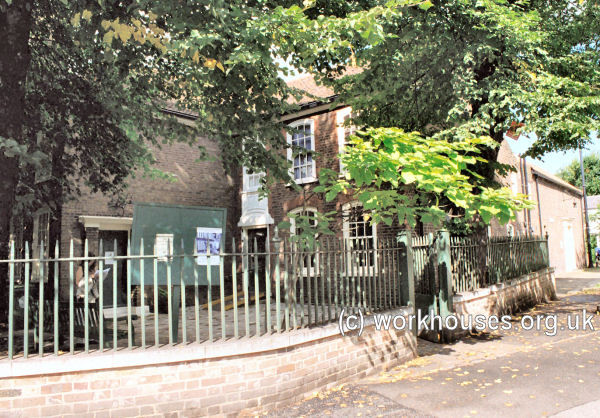
Walthamstow parish workhouse, 2000.
© Peter Higginbotham.
A plaque above the entrance door spelt out the ethos of the establishment: 'if any would not work neither Should he eat'.
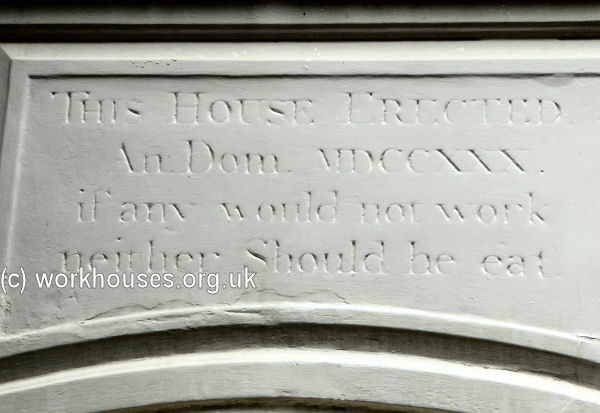
Walthamstow parish workhouse, 2000.
© Peter Higginbotham.
Gardens at the rear of the workhouse were used for the cultivation of fruit and vegetables.
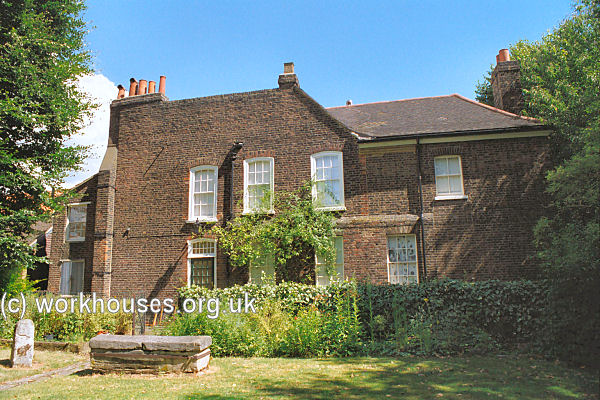
Walthamstow parish workhouse rear, 2000.
© Peter Higginbotham.
In 1830, a meeting of the Walthamstow vestry, adopted a new set of rules for its workhouse:
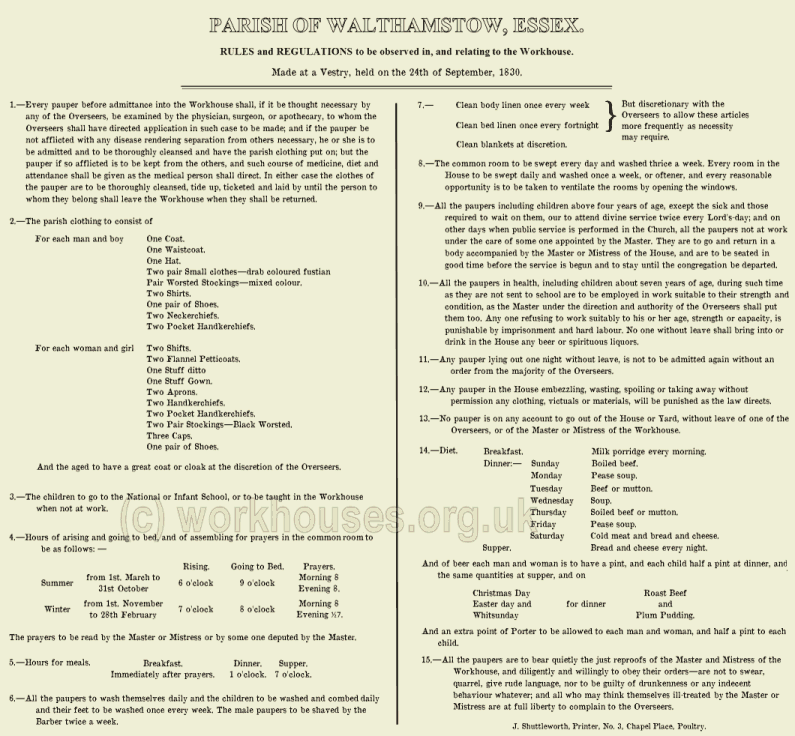
Walthamstow workhouse rules, 1830 (click on image for a larger version.)
The Walthamstow workhouse building now houses the Vestry House Museum and local archives.
Woodford set up a parish workhouse in 1723, while Leyton established one on Church Road in 1742 (Hitchcock, 1985).
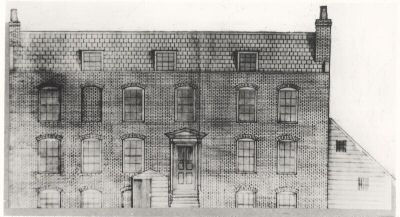
Leyton parish workhouse, 1742.
A parliamentary report of 1777 recorded parish workhouses in operation at West Ham (for up to 155 inmates), Leyton (30), and Walthamstow (50).
After 1834
West Ham Poor Law Union was formed on 31st May 1836. Its operation was overseen by an elected Board of Guardians, 24 in number, representing its 7 constituent parishes as listed below (figures in brackets indicate numbers of Guardians if more than one):
Essex:
East Ham (2), West Ham (10), Little Ilford, Low Leyton (3), Walthamstow (4), Wanstead (2), Woodford — St Mary (2).
Later Addition: Cann Hall (from 1894).
The population falling within the Union at the 1831 census was 24,770 with parishes ranging in size from Little Ilford (population 115) to West Ham itself (11,580). The average annual poor-rate expenditure for the period 1833-35 had been £14,714 or 11s.11d. per head of the population.
The Leyton Workhouse
A new West Ham Union workhouse was built in 1839-41 in Leyton. It was designed by Alfred Richard Mason and was based on a T-shaped main block, with lower wings to the rear creating two courtyards for the use of male and female inmates. The building was extended to provide additional accommodation in 1845. Its location and layout are shown on the 1867 OS map.
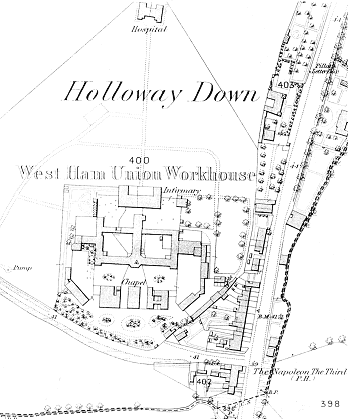
West Ham site, 1867.
The main block was a three-storey structure containing offices, infirm wards and a surgery on the ground floor, the Master and Matron's quarters and inmates' wards on the first floor, and lying-in infants' wards on the second floor. The rear wing contained a dining-room and stores and a kitchen in the basement.
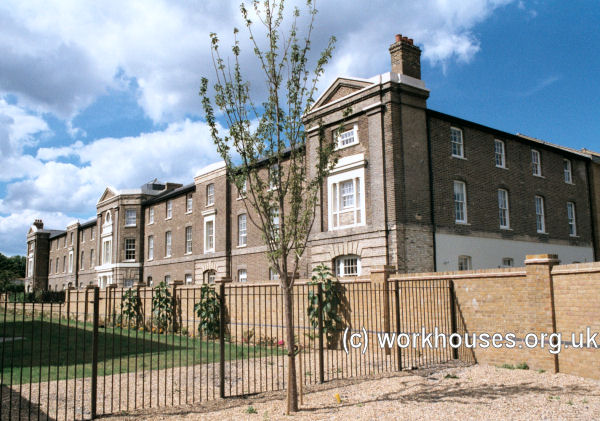
West Ham main block from the south-east, 2000.
© Peter Higginbotham.
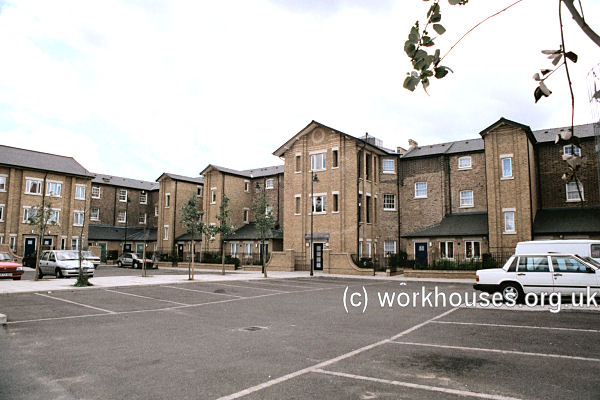
West Ham main block from the north-west, 2000.
© Peter Higginbotham.
A plain chapel was erected to the south of the workhouse in 1840.
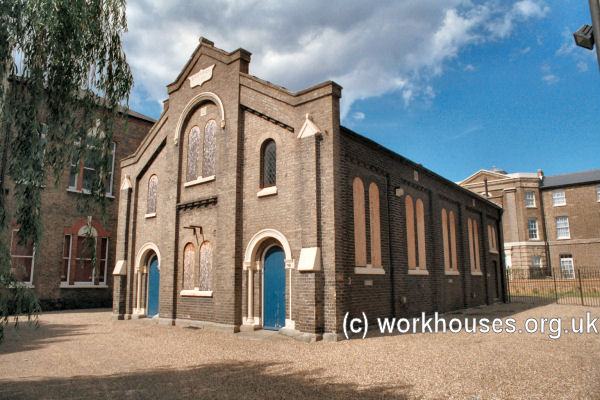
West Ham chapel, 2000.
© Peter Higginbotham.
To the west of the chapel was the board-room block which is believed to have been added in the 1870s and designed by Lewis Angell.
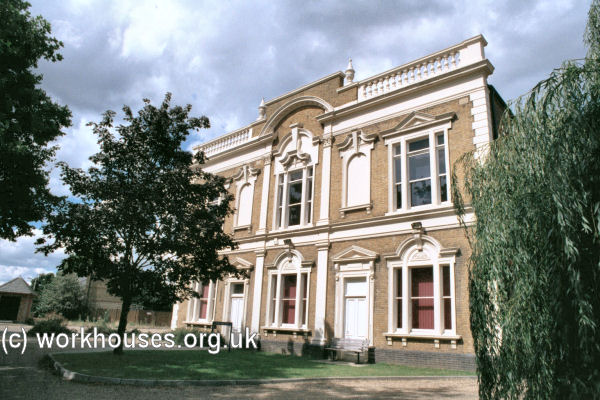
West Ham board-room block, 2000.
© Peter Higginbotham.
A matching but somewhat less ornate stores building lay to the east of the chapel.
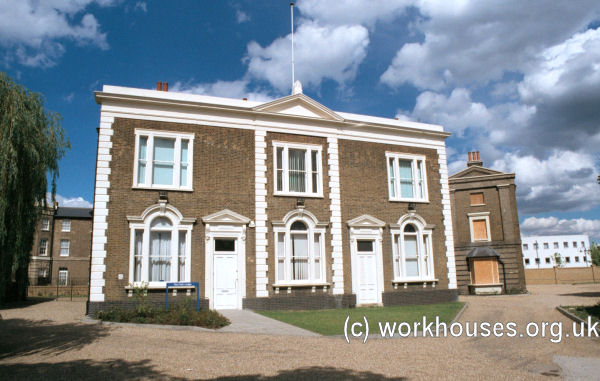
West Ham stores block, 2000.
© Peter Higginbotham.
In 1864, a 200-bed infirmary, now demolished was added at the west of the workhouse. The site layout in 1914 is shown below:
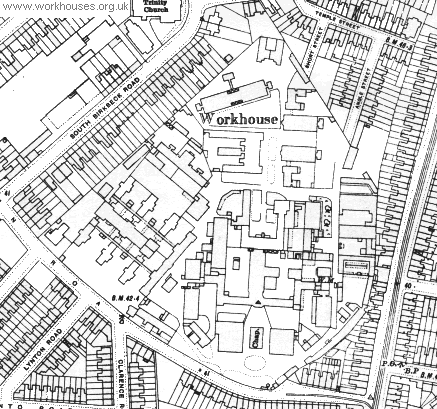
West Ham workhouse site, 1914.
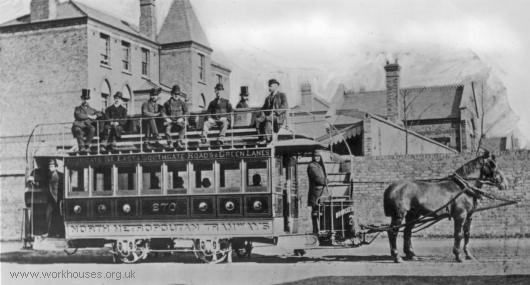
A North Metropolitan horse-tram thought to be at the south side of West Ham Workhouse, c.1890.
Extracts from the Guardians' minute books provide a taste of life in the workhouse:
- 3Oth October 1840
- It was resolved that in the main building 17 stoves for the sleeping rooms be not ordered but 4 stoves for the Masters' rooms be placed on order. In the boys establishment 2 stoves for Masters rooms be ordered and 3 stoves for the boys sleeping rooms — 1 small one only to be ordered for each.
- 3Oth June 1845
- It appeared on reference to the Pauper Offence Book that Elizabeth Pope an able-bodied pauper, having wilfully destroyed 2½ ozs. of bristles, the Master had punished her for such an offence by stopping her broth for 48 hours.
- 1st August 1845
- Elizabeth Connors and Sarah Mead — fighting in laundry — broth stopped for 48 hours.
- Henry Jones/William Hatherly — wilfully destroying fixtures in Mendicant Ward — taken before Magistrate.
- Lewis Reed — returning from Church intoxicated — beer stopped 48 hours.
- Esther Hayward — refractory conduct — broth stopped 48 hours.
- 20th September 1846
- ...that in consequence of the quality of the potatoes in the House being very bad, six ounces of bread be substituted on Sunday for dinner in lieu of potatoes. Three ounces of rice on Tuesdays and Thursdays in lieu of potatoes, and that in every other case in which potatoes are now provided for the children, rice be substituted.
- 28th August 1856
- ...in compliance with the request contained in the Poor Law Board's letter of the 13th instant it is resolved that the following dietary tables for the pauper children from 2-9 years of age be submitted for their sanction and approved:
2-5 years- Breakfast daily- 4½ oz. of bread and ½ pint milk
- Dinner- 4 ozs of meat daily except Friday, 10 ozs pudding on Fridays only.
8 ozs potatoes Sunday, Tuesday, Wednesday, Saturday, 10 ozs greens Monday and Thursday only. - Supper daily - 4½ ozs bread, ½ pint milk, ¼ ozs of butter.
As for 5-9 years but with an extra ½ oz bread per day and an extra ¼ oz of butter. - 3rd December 1857
- Resolved that the application of the four inmates named Avienberge, Millwood, Stevens and Cowell for an extra allowance of diet whilst being employed during extra hours in pumping' water be refused, and that they be not allowed whilst inmates of the Workhouse to return to the pump again nor yet be employed in the field but be set to pick oakum.
- 11 August 1859
- Alexander Barber stated that the boys in the Workhouse School were refused access to water to drink and that he had been told that for want of pure water they drunk soapsuds and from puddles in the yard. The Board recommended that a system with a permanent supply of pure water be provided at the school to which the boys could at any time have free access.
- 11th October 1888
- That in the face of so many murders and outrages being carried out in the East End of London it be a special instruction to the Officer of the Casual Ward to notice particularly all male applicants so as to endeavour to find, if possible, the delinquent.
In 1867, West Ham was the subject of one of a series of articles in the medical journal The Lancet investigating conditions in the country's workhouse infirmaries. The report included a number of criticisms about the establishment:
- Pauper boys in the main workhouse were in a pitiable condition.
- The "old infirmary" was overcrowded and badly ventilated
- The "new infirmary" lacked furniture and storage cupboards
- Waterclosets were placed too far from the infirmary wards
- The system of food distribution was inefficient
Further details of the Lancet inspection are in the full report.
The picture below is thought to be a ward in the women's side of the workhouse, decorated for Christmas.
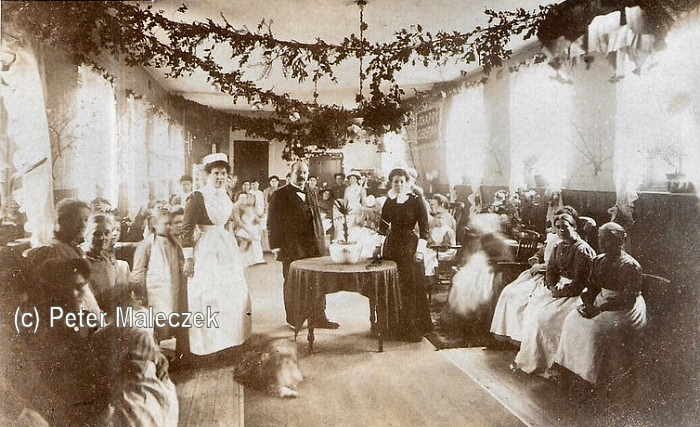
West Ham(?) workhouse, early 1900s.
© Peter Maleczek.
After the First World War, the site became known as the Central Home. In 1930, control passed to West Ham Borough Council, who ran it as a home for the chronic sick, aged and infirm. In 1936, it had around 1,800 beds. In 1948, with the inauguration of the National Health Service, it became a geriatric hospital and renamed Langthorne Hospital, forming part of the Leytonstone group of the North East Metropolitan Regional Hospital Board.
The site has now been redeveloped for residential use.
Whipp's Cross Hospital
In 1900-03, the West Ham Guardians erected a large new union infirmary at Whipp's Cross, Leytonstone. It was designed by Francis J Sturdy and was a typical pavilion plan design with male and female ward blocks placed either side a central administrative complex.
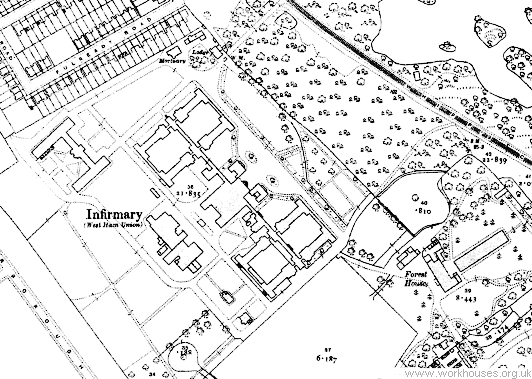
West Ham Whipp's Cross site, 1919.
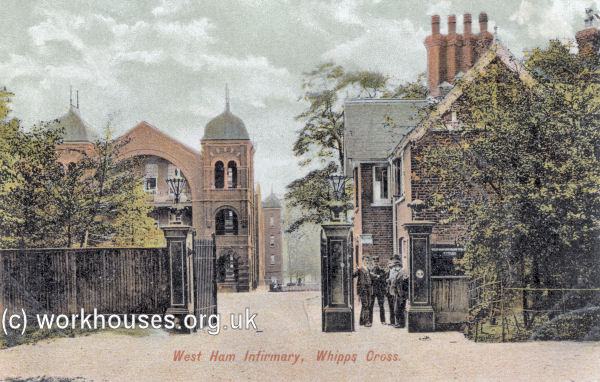
Whipp's Cross Hospital entrance, early 1900s.
© Peter Higginbotham.
A detailed description of the buildings appeared in The Builder in April, 1903.
INFIRMARY, LEYTONSTONE, N.E.
A NEW Infirmary for West Ham was opened by Mr. J. Lasham at Whipp's Cross, Leytonstone, N.E., recently. The estate comprises about forty-four acres of gardens, pleasure grounds, and meadow land, together with the mansion house (known as Forest House) and outbuildings, the lodge and cottage (since pulled down) in James-lane, and the cottage at the entrance to the estate in Whipp's Cross-road. The establishment is placed nearly parallel with the Whipp's Cross-road, the main entrance being reached by a roadway across a strip of forest land lying immediately to front of the boundary of the site. Generally, the plan is an administrative block centrally with two ward blocks right and left, connected by a covered corridor running from end to end of the building. Immediately in the rear of the administrative block is the boiler-house, laundry, and machinery building, and to the east of same are detached houses for the engineer and steward. On the south-west side of ward block D is the nurses' home, and near the Whipp's Cross-road entrance are the ambulance and stable buildings and the post-mortem room, mortuary, &c. The accommodation is as follows: — Ward A, six wards of twenty-four each, 144 ; twelve isolation wards of two each, twenty-four ; wards B, C, D, being exactly similar, 504; lunatic ward, two. The whole of the buildings are connected by a complete arrangement of fire-escape bridges, so that every ward has access to other blocks at each floor level, and these bridges are constructed by brick arching. In the administrative, right and left of the large entrance hall, are placed male and female receiving wards, each having attached a bathroom, and close by these wards are corridors connecting the medical superintendent's and assistant medical staff houses. Immediately behind the main corridor is the kitchen, and off this corridor, right and left, are the medical superintendent's office, stores, matron's rooms, workrooms, nurses' and probationers' rooms, dining-rooms, and behind the kitchen are sculleries and servants' hall. On the first floor in the rear are bedrooms for servants, and attached are bathrooms, &c. In the front is the chapel, accommodating 200, and off the main corridor, from this floor, storerooms and tanks in towers are reached.
The basement or lower ground floor of the ward blocks (for, owing to the fall of the land, the back portion is above ground) Is chiefly occupied by coal stores, but on the west side are steward's office, meat and milk stores, cellars, &c. Under the main corridor is a subway containing the steam, hot and cold-water pipes, hydrants. electric cables, &c, and the boiler-house is connected to the administrative block by means of a tunnel.
Each ward consists of a small central or administrative ward block, containing stairs, lifts, nurses' lavatories, &c., and from the main corridor at each floor level access to the large wards is gained by disconnecting lobbies or bridges. On entering one finds a dayroom, two isolation wards, a nurses' duty-room, and a linen store. In the tower annexes are the bathrooms and lavatories.
The nurses' home contains separate rooms for seventy - two nurses, superintendent's bed and sitting-rooms, whilst on the ground floor are recreation-rooms, for nurses and probationers, and these two rooms can be thrown into one, when required, for entertainments, &c. The laundry and boiler block consists of a self contained laundry with washing, drying, and ironing-rooms, with separate provision for staff, clothing disinfecting chamfer, and inmates' clothes store, and attached are living-rooms for the head laundress. In line with the boiler-house is the machine-room, containing engines, dynamos. &c, and behind is storage for batteries, &c. At the end of this building there is a carpenter's and smith's shop. The mortuary block contains a post-mortem-room and dead-house, and attached is a small chapel, together with a waiting room, &c. Adjacent is a stable building.
Between ward block B and the administrative building is the boardroom, access to which is gained through an ante-room from the main corridor at ground-floor level, and adjoining is a lavatory. Immediately under the boardroom there is a room of similar size, which is intended to be used for the purpose of religious services. Next the boardroom and between it and the administrative building is a detached ward, providing accommodation for short-period lunatics, and containing a ward for two, bathroom, lavatory, attendant's-room, and, leading from this, a padded-room. On the opposite side of the administrative block and between it and D block is the dispensary, a detached building connected to the main corridor at ground-floor level ; this contains, in addition to the dispensary, an office, and the basement or lower ground floor is occupied by the drug store. Right and left of the entrance hall and chapel building are respectively the medical superintendent's house and the medical staff quarters. The former is a commodious residence for the medical officer, and is connected to the main entrance hall, though the building is detached, and the latter, connected in a similar manner, contains bed and sitting-rooms for three assistant medical officers, together with a common room for dining. &c., and the remaining half of this house is occupied by a suite of rooms for the matron and two assistants. On each floor are two bathrooms and lavatories, &c. and on the ground floor a further lavatory in addition.
Externally the buildings are faced with red bricks, obtained locally, with Bath and Portland stone dressings, the roofs of the chapel, towers, and staff quarters being covered with green slates. The walls of bathrooms, kitchen, sculleries, dynamo-room, and some stores are faced with glazed bricks, the dayrooms having dados in salt-glazed bricks. The walls of wards are finished with Keene's cement painted, with skirtings in glazed bricks. The corridors are in all cases of fireproof materials, finished with terrazzo, or artificial stone. The buildings are warmed by radiators when necessary, as auxiliary heating to the open fireplaces. Each large ward has a double-fire descending flue stove, and the separation wards have warm-air grates. The electric lighting has been carried out by Messrs. F. A. Glover & Co., Ltd., of London. The lifts were provided and fitted-by Messrs. C. & A. Masker, Ltd., of Liverpool. There are eleven lifts in all, four, being one in each of the blocks, A, B, C, D, for patients, four in the same blocks are dinner-lifts, and the remaining three are service-lifts The kitchens have been fitted by Messrs. Benham & Sons, Ltd. The water supply to the institution is obtained either from the East London Water Co.'s mains, delivered direct to the steel storage tanks in the water towers ; or the alternative provision (and the one to be most largely drawn upon) is from the artesian well sunk by Messrs. Isler & Co., to a depth of 400 ft., and which is expected will yield sufficient water to meet the demand of the institution.
Messrs. Shillitoe & Sons, of Bury St. Edmunds, have been the general contractors, Mr. H. Fawcet being the works manager, Mr. T. E. Edmunds has acted as clerk to the works, and Mr. John Buley, of Laurence Pountney Hill, Cannon-street, E.C., has superintended the engineering works for the Guardians, and Mr. A. T. Walmisley, M.Inst.C E., of Westminster, has acted as consulting engineer to the architect. The stoves and ranges have been supplied by Messrs Hendry & Pattisson, and Carter & Aynsley ; the glazed bricks by Brookes. of Halifax, and the red bricks by Cornish, of Shenfield. The stonework was by F. Mortimer, of Walthamstow; heating and hot-water work by Wontner, Smith, Gray, & Co. ; the hydrants by Shand, Mason, & Co. ; the road-making by H. V. Manders ; the marble mosaic and terrazzo flooring by Pattesson & Co. of Manchester, and the Art Pavements and Decorations Co., Ltd. ; electric bells, Jackson Bros. ; glazing to chapels, Lowndes & Drury ; steel tanks, Steavenson & Co. ; covering to boilers, Dick's Asbestos Co. ; fencing, Bayliss, Jones, & Co., and E. C. White ; water softener, Stanhope Water Co.; floor polishing. Ronuk, Ltd. ; engineers for well pumps, J. Reedman & Co. Mr. Crow, of Stratford, supplied the clock and bells. The architect to the Guardians is Mr. Francis J Sturdy, of London. The amount of the building contract was 186,665l.
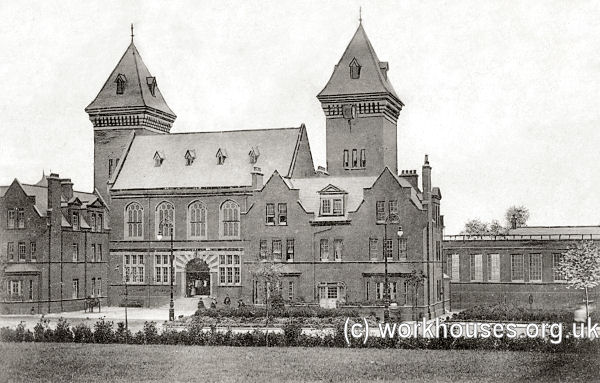
Whipp's Cross entrance to administrative building from the south-west, c.1904.
© Peter Higginbotham.
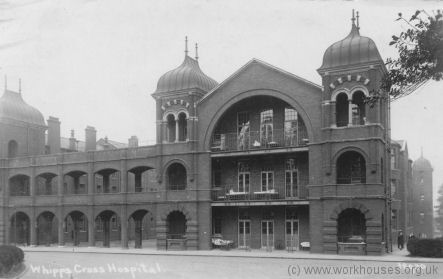
Whipp's Cross western ward block from the north, c.1936.
© Peter Higginbotham.
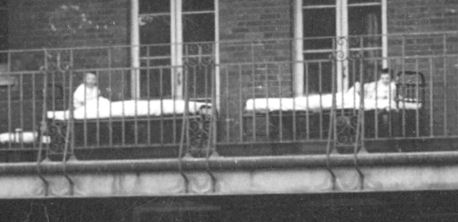
Whipp's Cross western ward block detail, c.1936.
© Peter Higginbotham.
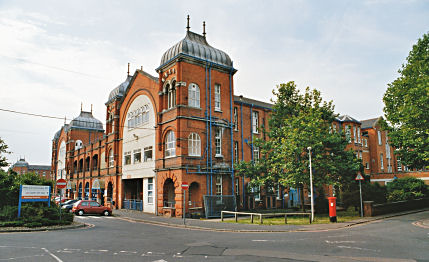
Whipp's Cross western ward block from the north-west, 2004.
© Peter Higginbotham.
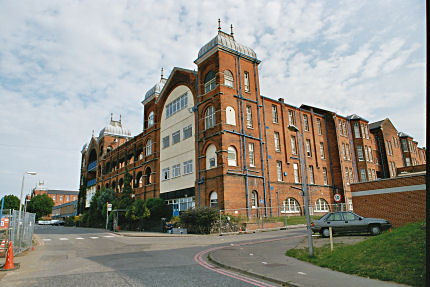
Whipp's Cross eastern ward block from the south-east, 2004.
© Peter Higginbotham.
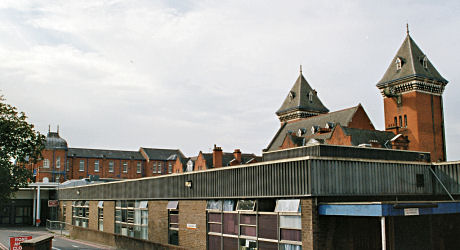
Whipp's Cross administrative building from the north-west, 2004.
© Peter Higginbotham.
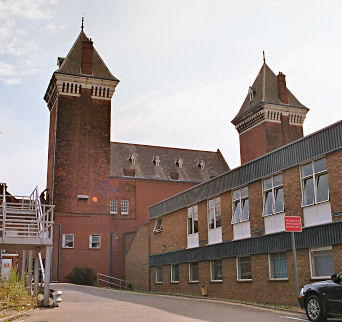
Whipp's Cross rear of administrative building from the south-west, 2004.
© Peter Higginbotham.
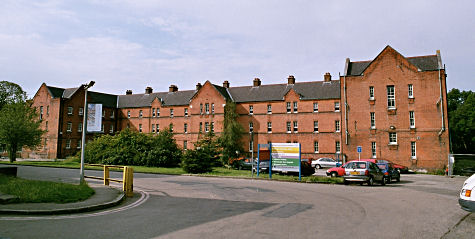
Whipp's Cross nurse's home from the north, 2004.
© Peter Higginbotham.
The site still operates as Whipps Cross Hospital.
Margate Convalescent Home
In 1900, the union acquired the former Metropolitan Infirmary for Children at Margate for use as a seaside convalescent home.
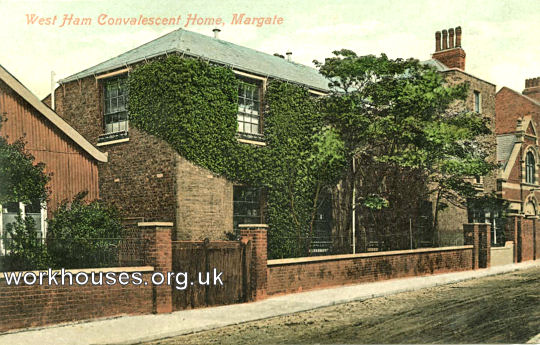
West Ham Convalescent Home, Margate, early 1900s.
Children's Homes
In the 1870s, West Ham had experimented with housing children in the then novel cottage homes style of accommodation. In West Ham's case, however, the homes were constructed on the main workhouse site (the exact location is unclear) and housed around fifty children in each, a number which rather rules them out as being true cottage homes.
West Ham later placed many of its poor law children in scattered homes, where a group of children were looked after by a house-parent and attended local schools. By 1913, the union had scattered homes at 31 and 31B, 96, 98, 100, 102 Ferndale Road, Leytonstone and 21-27 Pelham Road, South Woodford. In the mid-1920s, there were also homes at Savage Gardens, East Ham; Ashford Road, South Woodford; Davies Lane, Leytonstone; Capel Road, Forest Gate; Keogh Road, Stratford; and Pulteney Road, South Woodford.
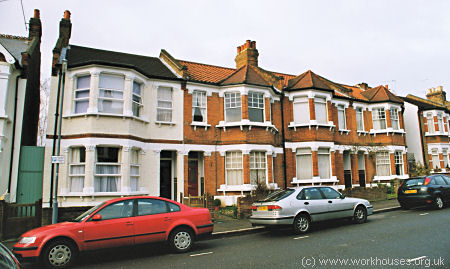
Scattered Homes at 21-27 Pelham Road, 2004.
© Peter Higginbotham.
The West Ham Guardians had a receiving home for children on Jupp Road, Stratford, London E15. In 1911, the home had 130 children in residence, 93 boys and 37 girls, aged from 3 to 17 years. The Sueprintendent was James Berry Pitts, with his wife Janet as Matron.
In 1907, the Guardians purchased a site at Aldersbrook on which, in 1910, they erected receiving homes for children being placed in the union's scattered homes. The location and layout of the Aldersbrook site is shown on the 1915 map below.
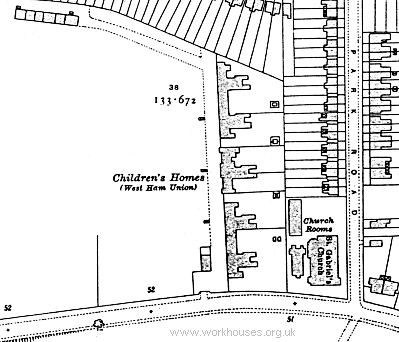
Aldersbrook site, 1915.
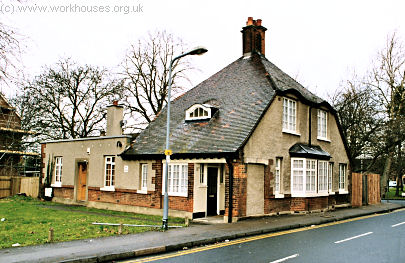
Aldersbrook Homes lodge from the south-east, 2004.
© Peter Higginbotham.
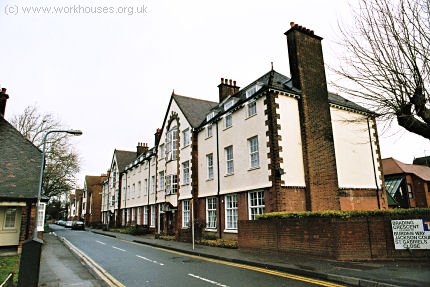
Aldersbrook Homes from the south, 2004.
© Peter Higginbotham.
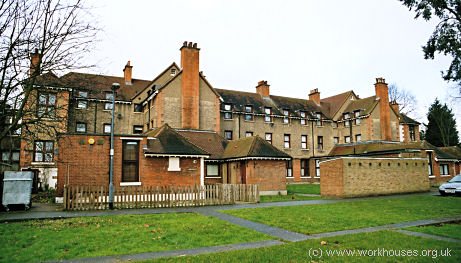
Aldersbrook Homes from the east, 2004.
© Peter Higginbotham.
The homes were subsequently taken over by East Ham County Borough who added a recreation hall in 1931.
The homes have now been converted to flats.
Staff
Inmates
Records
Note: many repositories impose a closure period of up to 100 years for records identifying individuals. Before travelling a long distance, always check that the records you want to consult will be available.
- Newham Archives and Local Studies Library, Stratford Library, 3 The Grove, London E15 1EL. Holdings: Guardians' Minutes (1836-1930); Central Home admissions - women and children only (1906-18 (incomplete) and 1918-1959); Printed Guardians' reports (1906-1930); Statements of accounts (1902-1926).
- Records for baptisms of children from the workhouse (beginning in 1880), performed at Holy Trinity Church, Harrow Green, have been transcribed by Waltham Forest FHS and can be searched online.
Bibliography
- Hitchcock, T.V. (1985) The English workhouse: a study in institutional poor relief in selected counties. l695-l750. (DPhil thesis. University of Oxford.)
Links
Unless otherwise indicated, this page () is copyright Peter Higginbotham. Contents may not be reproduced without permission.


